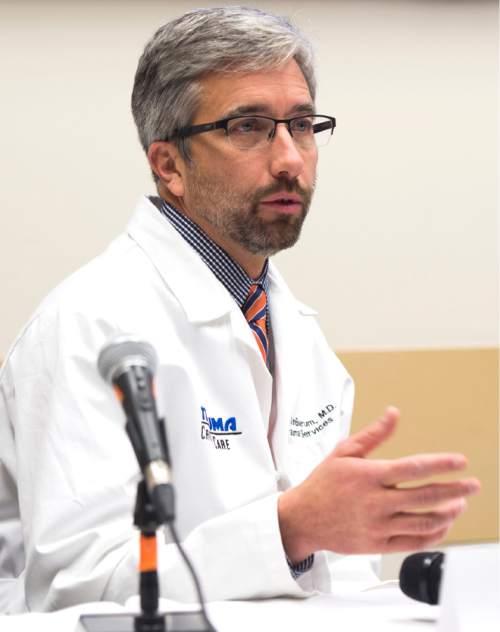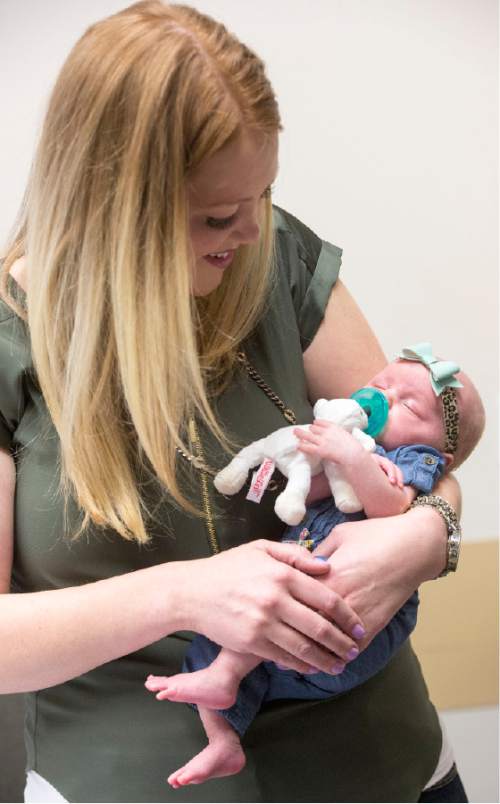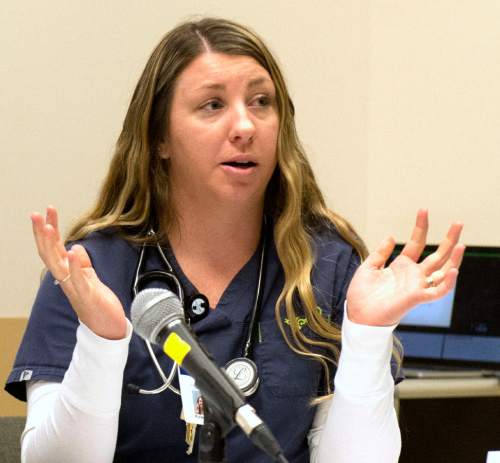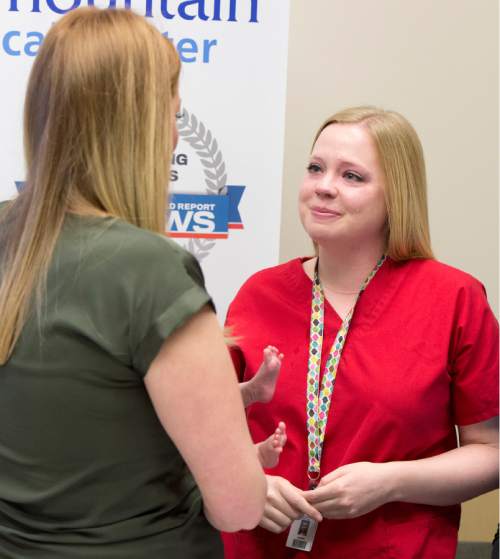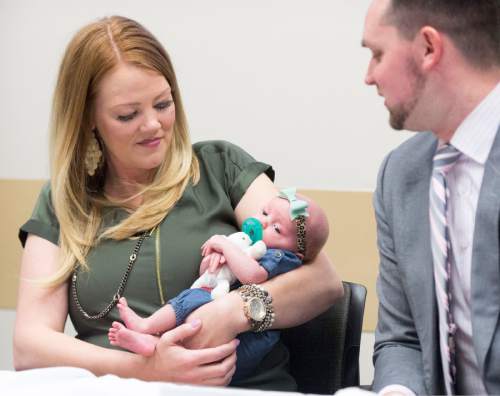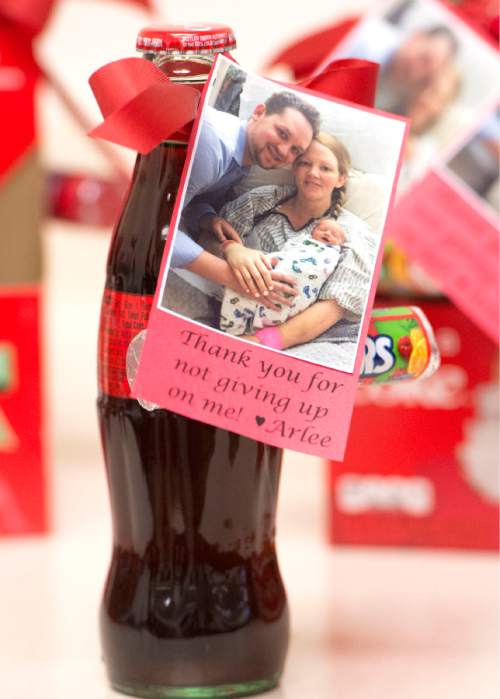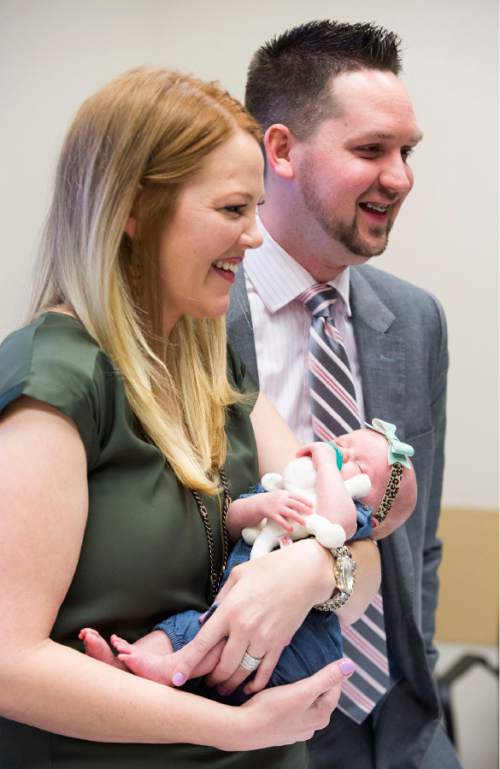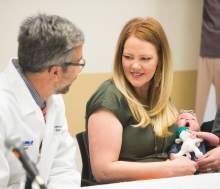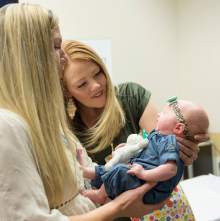Rick Egan | The Salt Lake Tribune
Dr Don Van Boerum talks about what was required to save the life of Arlee Gregerson, at the I
Rick Egan | The Salt Lake Tribune
Arlee Gregerson holds baby Lucy at the Intermountain Medical Center. When Lucy was two days
Rick Egan | The Salt Lake Tribune
Kaley Graham, RN, talks about saving the life of Arlee Grererson, at the Intermountain Medica
Rick Egan | The Salt Lake Tribune
Maternity RN Kristy Russell talks about her role in saving the life of Arlee Gregerson at the
Rick Egan | The Salt Lake Tribune
Lauren Fredrickson, Medical Laboratory Scientist visits with Arlee Gregerson, at the Intermou
Rick Egan | The Salt Lake Tribune
Arlee Gregerson listens as her husband Ryan tells his side of the story, at the Intermountain
Rick Egan | The Salt Lake Tribune
Lauren Fredrickson, Medical Laboratory Scientist visits with Arlee Gregerson, at the Intermou
Rick Egan | The Salt Lake Tribune
Arlee and Ryan Gregerson, hold their baby Lucy, at the Intermountain Medical Center. When L
Rick Egan | The Salt Lake Tribune
Dr Don Van Boerum visits with Arlee Gregerson, at the Intermountain Medical Center. When Luc
Rick Egan | The Salt Lake Tribune
Melissa Fox, RN at Intermountain Medical Center, When Lucy was two days old, Arlee Gregerson
Rick Egan | The Salt Lake Tribune
Melissa Fox, (left) RN at Intermountain Medical Center, holds Lucy, Arlee Gregerson's baby,
Rick Egan | The Salt Lake Tribune
Arlee Gregerson talks about her incident at the hospital as her husband Ryan listens, at the
Rick Egan | The Salt Lake Tribune
Melissa Fox, RN at Intermountain Medical Center, When Lucy was two days old, Arlee Gregerson
Rick Egan | The Salt Lake Tribune
The Family of Arlee Grererson, made gifts for the medical team that saved Arlee's life, at th
Rick Egan | The Salt Lake Tribune
Arlee and Ryan Gregerson, smile as they hold their baby Lucy, at the Intermountain Medical C
Rick Egan | The Salt Lake Tribune
Dr Don Van Boerum talks about what was required to save the life of Arlee Gregerson, at the Intermountain Medical Center. When Lucy was two days old, Arlee Gregerson nearly died, but thanks to the swift CPR action by Melissa Fox, and life-saving coordination of medical teams at Intermountain Medical Center in Murray, Arlee and her baby are both doing well. They returned to the hospital to reunite with the doctors and nurses who saved her life one month ago. Thursday, December 17, 2015.
Rick Egan | The Salt Lake Tribune
Arlee Gregerson holds baby Lucy at the Intermountain Medical Center. When Lucy was two days old, Arlee Gregerson nearly died, but thanks to the swift action and life-saving coordination of medical teams at Intermountain Medical Center in Murray, Arlee and her baby are both doing well. They returned to the hospital to reunite with the doctors and nurses who saved her life one month ago. Thursday, December 17, 2015.
Rick Egan | The Salt Lake Tribune
Kaley Graham, RN, talks about saving the life of Arlee Grererson, at the Intermountain Medical Center. When Lucy was two days old, Arlee Gregerson nearly died, but thanks to the swift action and life-saving coordination of medical teams at Intermountain Medical Center in Murray, Arlee and her baby are both doing well. They returned to the hospital to reunite with the doctors and nurses who saved her life one month ago. Thursday, December 17, 2015.
Rick Egan | The Salt Lake Tribune
Maternity RN Kristy Russell talks about her role in saving the life of Arlee Gregerson at the Intermountain Medical Center. When Lucy was two days old, Arlee Gregerson nearly died, but thanks to the swift action and life-saving coordination of medical teams at Intermountain Medical Center in Murray, Arlee and her baby are both doing well. They returned to the hospital to reunite with the doctors and nurses who saved her life one month ago. Thursday, December 17, 2015.
Rick Egan | The Salt Lake Tribune
Lauren Fredrickson, Medical Laboratory Scientist visits with Arlee Gregerson, at the Intermountain Medical Center. When Lucy was two days old, Arlee Gregerson nearly died, but thanks to the swift action and life-saving coordination of medical teams at Intermountain Medical Center in Murray, Arlee and her baby are both doing well. They returned to the hospital to reunite with the doctors and nurses who saved her life one month ago. Thursday, December 17, 2015.
Rick Egan | The Salt Lake Tribune
Arlee Gregerson listens as her husband Ryan tells his side of the story, at the Intermountain Medical Center. When Lucy was two days old, Arlee Gregerson nearly died, but thanks to the swift action and life-saving coordination of medical teams at Intermountain Medical Center in Murray, Arlee and her baby are both doing well. They returned to the hospital to reunite with the doctors and nurses who saved her life one month ago. Thursday, December 17, 2015.
Rick Egan | The Salt Lake Tribune
Lauren Fredrickson, Medical Laboratory Scientist visits with Arlee Gregerson, at the Intermountain Medical Center. When Lucy was two days old, Arlee Gregerson nearly died, but thanks to the swift action and life-saving coordination of medical teams at Intermountain Medical Center in Murray, Arlee and her baby are both doing well. They returned to the hospital to reunite with the doctors and nurses who saved her life one month ago. Thursday, December 17, 2015.
Rick Egan | The Salt Lake Tribune
Arlee and Ryan Gregerson, hold their baby Lucy, at the Intermountain Medical Center. When Lucy was two days old, Arlee Gregerson nearly died, but thanks to the swift action and life-saving coordination of medical teams at Intermountain Medical Center in Murray, Arlee and her baby are both doing well. They returned to the hospital to reunite with the doctors and nurses who saved her life one month ago. Thursday, December 17, 2015.
Rick Egan | The Salt Lake Tribune
Dr Don Van Boerum visits with Arlee Gregerson, at the Intermountain Medical Center. When Lucy was two days old, Arlee Gregerson nearly died, but thanks to the swift CPR action by Melissa Fox, and life-saving coordination of medical teams at Intermountain Medical Center in Murray, Arlee and her baby are both doing well. They returned to the hospital to reunite with the doctors and nurses who saved her life one month ago. Thursday, December 17, 2015.
Rick Egan | The Salt Lake Tribune
Melissa Fox, RN at Intermountain Medical Center, When Lucy was two days old, Arlee Gregerson nearly died, but thanks to the swift CPR action by Melissa Fox, and life-saving coordination of medical teams at Intermountain Medical Center in Murray, Arlee and her baby are both doing well. They returned to the hospital to reunite with the doctors and nurses who saved her life one month ago. Thursday, December 17, 2015.
Rick Egan | The Salt Lake Tribune
Melissa Fox, (left) RN at Intermountain Medical Center, holds Lucy, Arlee Gregerson's baby, at the Intermountain Medical Center. When Lucy was two days old, Arlee Gregerson nearly died, but thanks to the swift CPR action by Melissa Fox, and life-saving coordination of medical teams at Intermountain Medical Center in Murray, Arlee and her baby are both doing well. They returned to the hospital to reunite with the doctors and nurses who saved her life one month ago. Thursday, December 17, 2015.
Rick Egan | The Salt Lake Tribune
Arlee Gregerson talks about her incident at the hospital as her husband Ryan listens, at the Intermountain Medical Center. When Lucy was two days old, Arlee Gregerson nearly died, but thanks to the swift action and life-saving coordination of medical teams at Intermountain Medical Center in Murray, Arlee and her baby are both doing well. They returned to the hospital to reunite with the doctors and nurses who saved her life one month ago. Thursday, December 17, 2015.
Rick Egan | The Salt Lake Tribune
Melissa Fox, RN at Intermountain Medical Center, When Lucy was two days old, Arlee Gregerson nearly died, but thanks to the swift CPR action by Melissa Fox, and life-saving coordination of medical teams at Intermountain Medical Center in Murray, Arlee and her baby are both doing well. They returned to the hospital to reunite with the doctors and nurses who saved her life one month ago. Thursday, December 17, 2015.
Rick Egan | The Salt Lake Tribune
The Family of Arlee Grererson, made gifts for the medical team that saved Arlee's life, at the Intermountain Medical Center. When Lucy was two days old, Arlee Gregerson nearly died, but thanks to the swift action and life-saving coordination of medical teams at Intermountain Medical Center in Murray, Arlee and her baby are both doing well. They returned to the hospital to reunite with the doctors and nurses who saved her life one month ago. Thursday, December 17, 2015.
Rick Egan | The Salt Lake Tribune
Arlee and Ryan Gregerson, smile as they hold their baby Lucy, at the Intermountain Medical Center. When Lucy was two days old, Arlee Gregerson nearly died, but thanks to the swift action and life-saving coordination of medical teams at Intermountain Medical Center in Murray, Arlee and her baby are both doing well. They returned to the hospital to reunite with the doctors and nurses who saved her life one month ago. Thursday, December 17, 2015.


